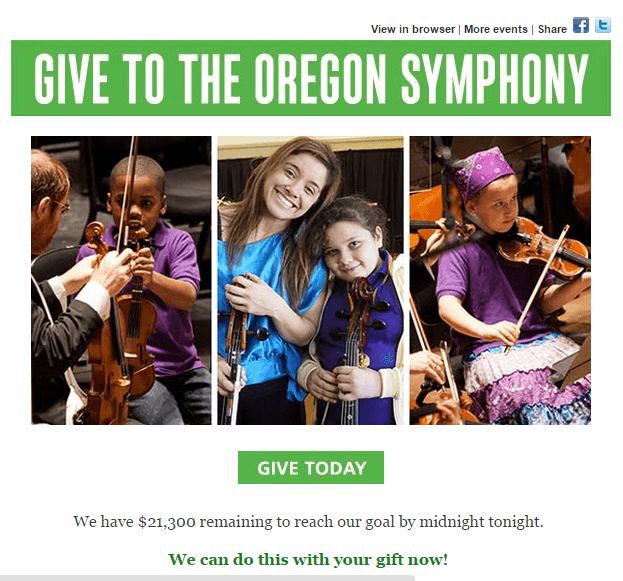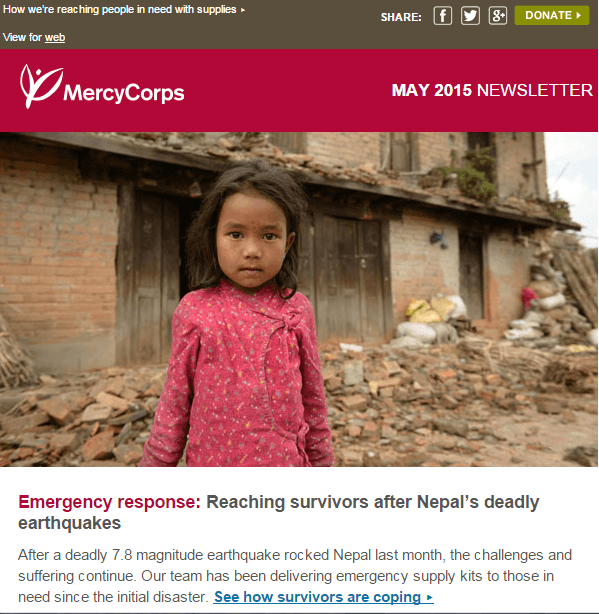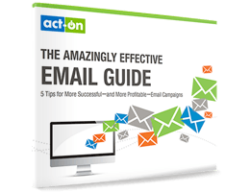Asking for money isn’t easy, especially when you’re not providing a product or service in return. That’s why marketers working for nonprofit organizations face their own unique challenges when it comes to putting together effective email campaigns. How can you make sure your fundraising messages get opened and read? What words and phrases get the best results? What can you do to increase response rates?
Let’s talk about some best practices that relate to every type of direct-response email, as well as a few tips that are specific to nonprofit organizations.
There are thousands of nonprofits in the United States today. Their focuses range across a variety of causes, from art and media like National Public Radio, the Museum of Modern Art, and TED to humanitarian charities like UNICEF and MercyCorps, or champions of environmental causes such as Green Peace and Sierra Club. And there are billions of dollars at stake. According to Giving USA, Americans donated an estimated $358.38 billion to charity in 2014.
A quick look in your own inbox will probably tell you that a lot of the individual contributions were generated through email campaigns. So what can you do as a nonprofit marketer to get better results out of your email campaigns? Here are five email marketing tips for nonprofit organizations.
1. Focus on Improving Deliverability Rates
According to a recent study by EveryAction, 1 in 8 nonprofit emails never reach an inbox. In fact, of all the emails delivered by nonprofits in 2014, 12.3% ended up in spam folders. The report also found that by reducing the number of emails that are flagged as spam, nonprofits could increase email revenue by 14%. There are many reasons your email could be identified as spam. If you don’t provide a single-click opt-out link, or if you’re using an old list, you can significantly increase your risk. But what’s more, if you send emails that people aren’t interested in – and don’t ever engage with – you also risk having ISPs classify your message as spam. Learn more about maximizing email deliverability in this eBook.
2. Keep the Call to Action Simple
 While it may be tempting to ask for as much as much as you can in one message to avoid barraging your recipients with multiple requests for donations, you should try to focus on a single call to action in your email. Keep it simple and make it obvious. What one thing do you want people to do when they get your message? Put that action front and center and don’t waste a lot of time getting to the point. If possible, be specific in your ask. Rather than “Help Us Fight Hunger” you might want to say “Donate $1 to Feed a Child in Tibet Today.” Here are seven tips for creating a better call to action.
While it may be tempting to ask for as much as much as you can in one message to avoid barraging your recipients with multiple requests for donations, you should try to focus on a single call to action in your email. Keep it simple and make it obvious. What one thing do you want people to do when they get your message? Put that action front and center and don’t waste a lot of time getting to the point. If possible, be specific in your ask. Rather than “Help Us Fight Hunger” you might want to say “Donate $1 to Feed a Child in Tibet Today.” Here are seven tips for creating a better call to action.
3. Test Every Aspect of Your Message
All of the different elements of your email, from the subject line and “From” address to the headline, images, body copy, and call to action, are potential subjects of an A/B test. Do photos of kittens or puppies get more donations to your animal shelter? Should you include a specific dollar amount or leave it up to the recipient to decide? Testing is the only way to be sure. According to the Direct Marketing Association, 68% of digital marketers rated the ability to test new campaigns as having the greatest impact on their email marketing efforts. Learn how to test email messages as well as landing pages in this eBook, The ABCs of A/B Testing.
 4. Make it Personal
4. Make it Personal
The most effective content is personalized to the reader who receives it. Find out which causes and interests are the most important to each of the segments of your audience and focus your email message around those topics. Include their name in the subject line and add information that relates to any behavior you’ve tracked or donations you have on record. For example, you can send a follow up email to let a donor know how their money is being used to help a particular cause, which might create a positive emotion. Find out how to use personalization and dynamic content in your email campaigns.
Here’s another way to ensure the personal touch: Instead of talking about your organization as a whole, you might want to write an email from a particular member of your staff or one of the volunteers. Tell stories or ask the recipients of the donations to tell their own stories. Engage your donors in your work and reinforce their giving decisions, so you can inspire them to do more, and encourage them to spread the word on your behalf. Include photos of real people to make the appeal even more personal.
5. Remember the Mobile Experience
Making sure your email looks good and provides an excellent user experiences on a mobile device is critical. According to US Consumer Device Preference Report, 65% of all emails get opened on a mobile device. If you make your recipients have to pinch or zoom in just to read your message, you’re going to lose their attention fast. And if you have a lot of little links jammed together that are impossible to click with a fingertip, you’ll end up frustrating your audience. And a frustrated person is much less likely to give to your cause. Here are a few things you can do to make your email more mobile-friendly:
- Provide plenty of white space: You should already be doing this to improve readability. But it’s essential for mobile emails – especially around links and buttons.
- Leave room for copy: The text of your email grows, shrinks, or changes slightly between devices. That’s because of the differences in font rendering between different platforms, which means you’ll want to make space for it.
- Keep load times short: Big images are the main reason file sizes get huge, so keep your image sizes down.
- Don’t assume everyone is using the latest device: Some mobile devices are older and slower, and your recipients may be downloading content over a lower-grade connection. Check your email across multiple devices and email clients.
A professional, easy-to-read email design is critical to the success of any email campaign. But it’s particularly important for nonprofits, because in order to gain the support of your members, first you must gain their trust. Well-designed email templates will not only increase engagement and clickthroughs, they’ll also make your organizations stand out (in a positive way) in the minds of your audience.
 Be sure to read the amazingly effective email guide to get more tips for successful marketing campaigns, and learn how Act-On solutions can help nonprofits grow deeper relationships with donors.
Be sure to read the amazingly effective email guide to get more tips for successful marketing campaigns, and learn how Act-On solutions can help nonprofits grow deeper relationships with donors.
